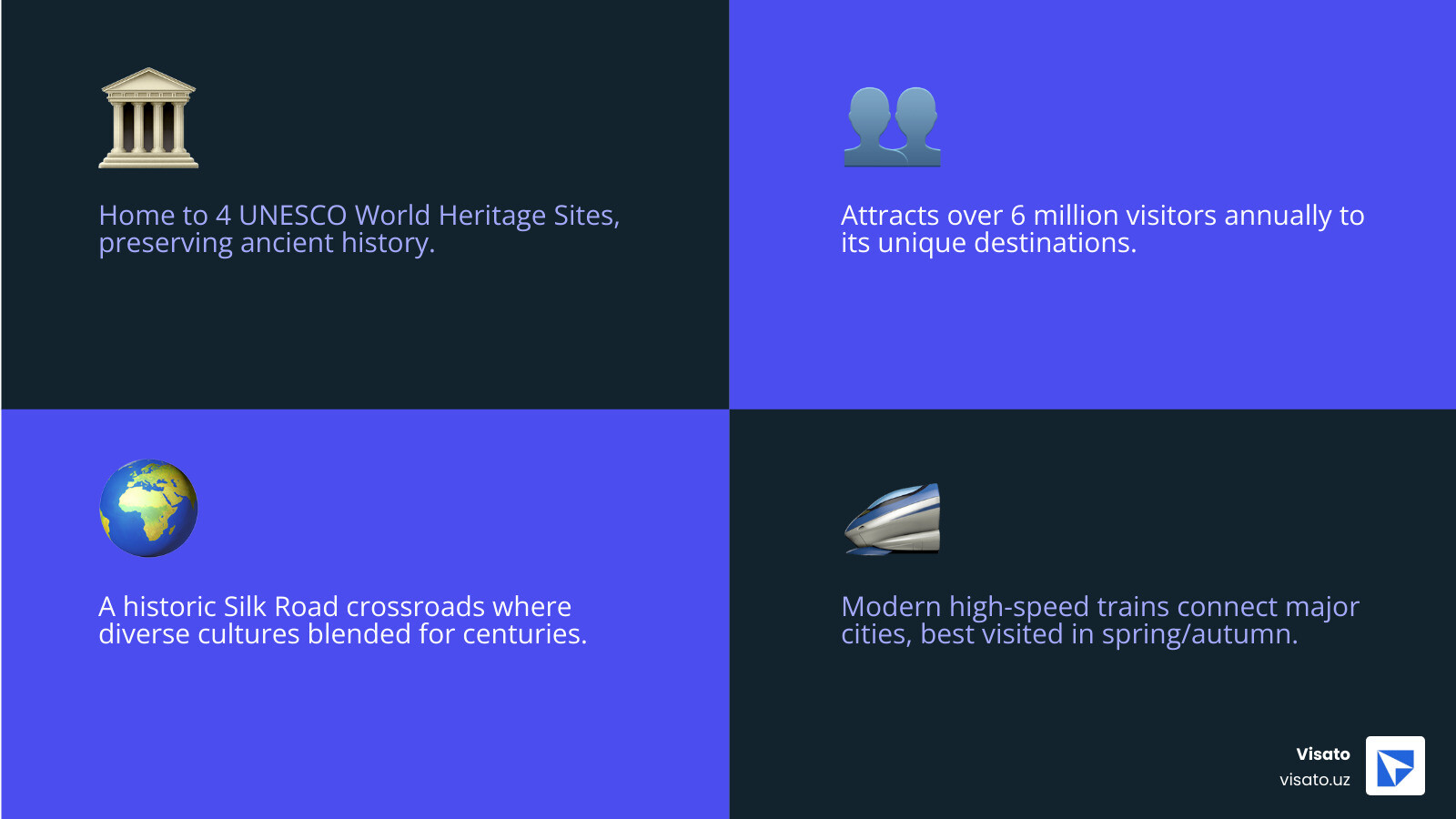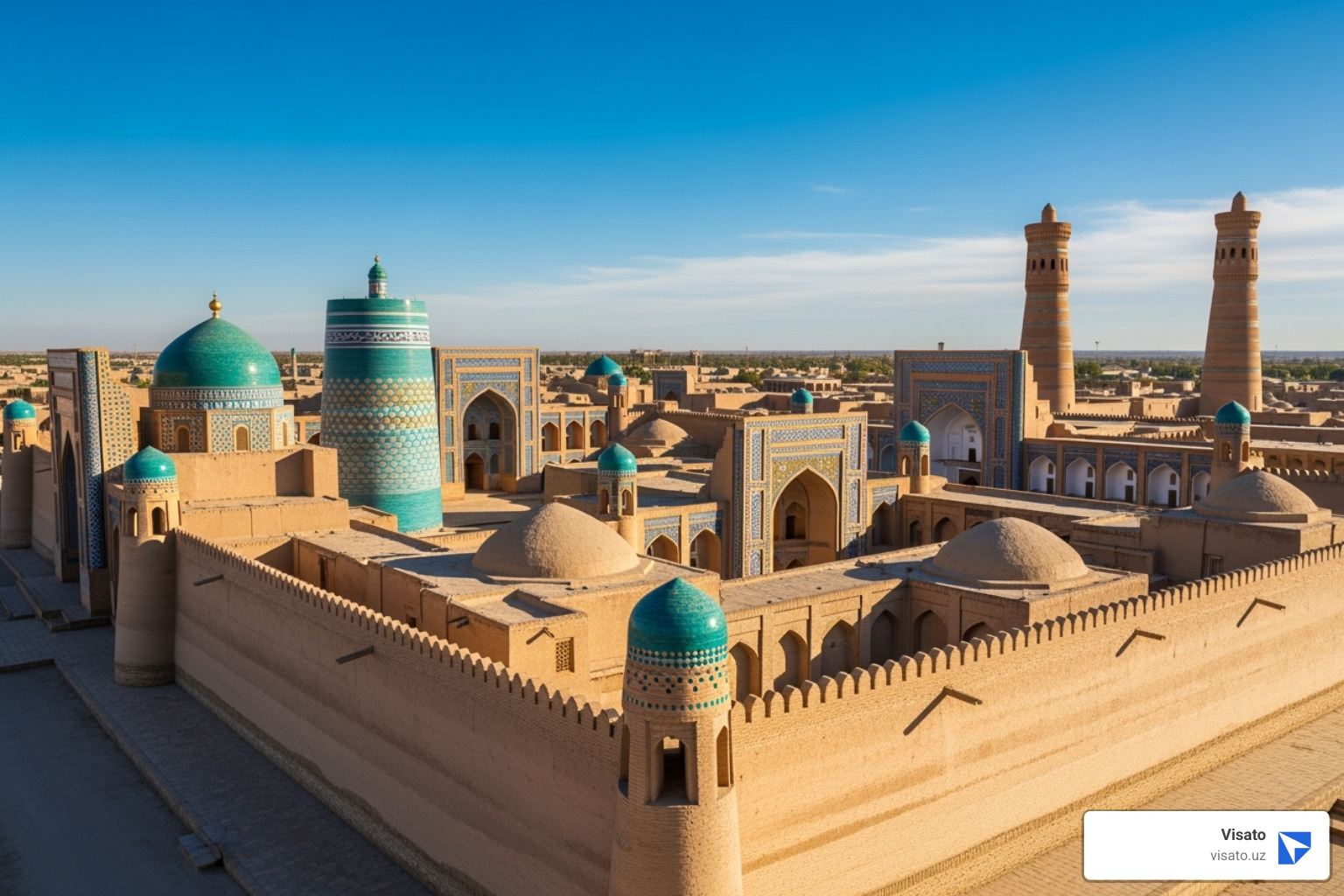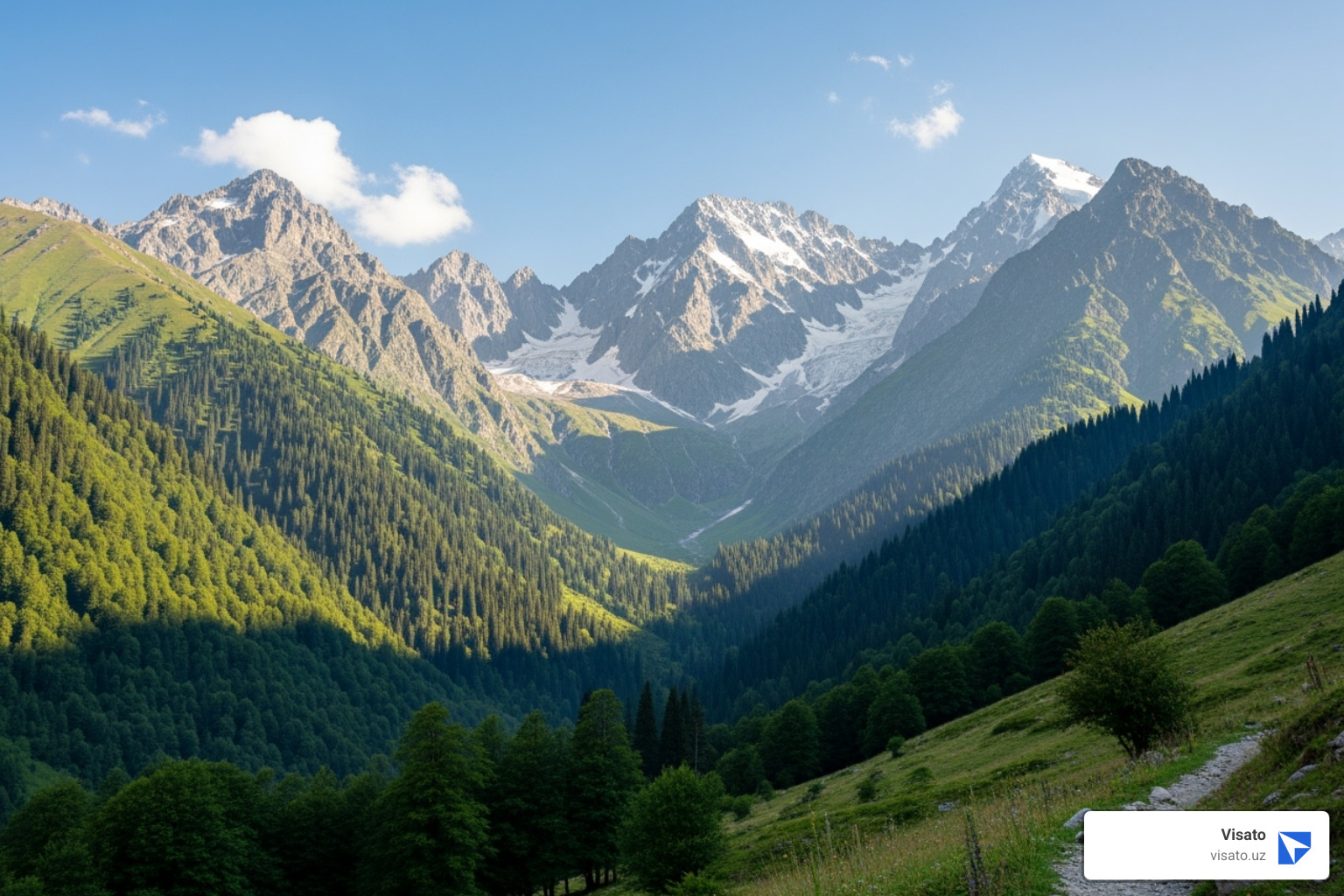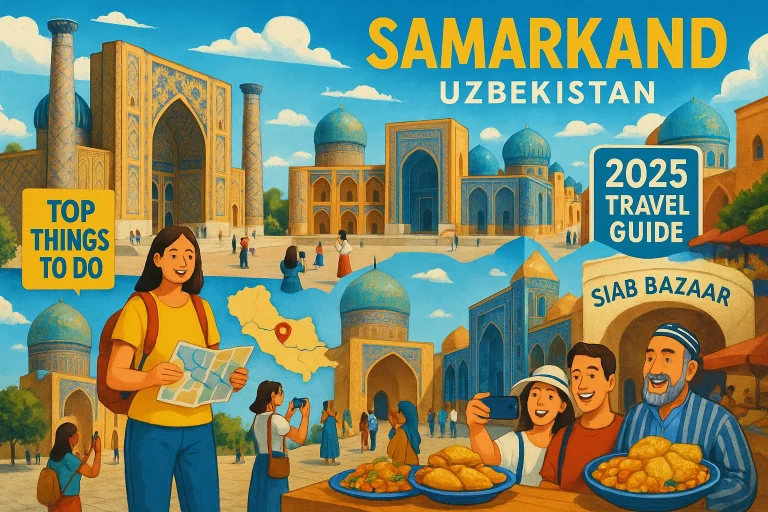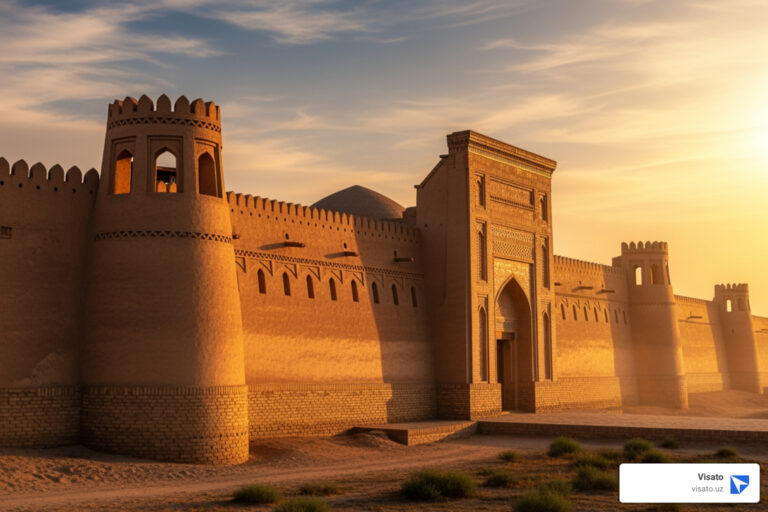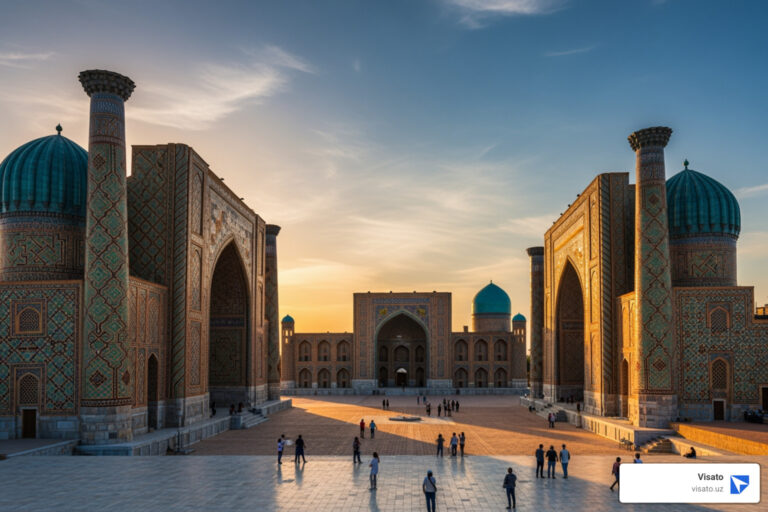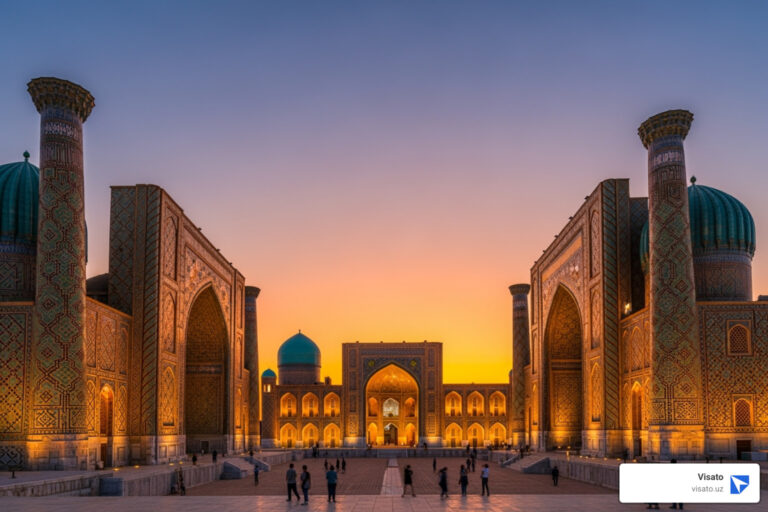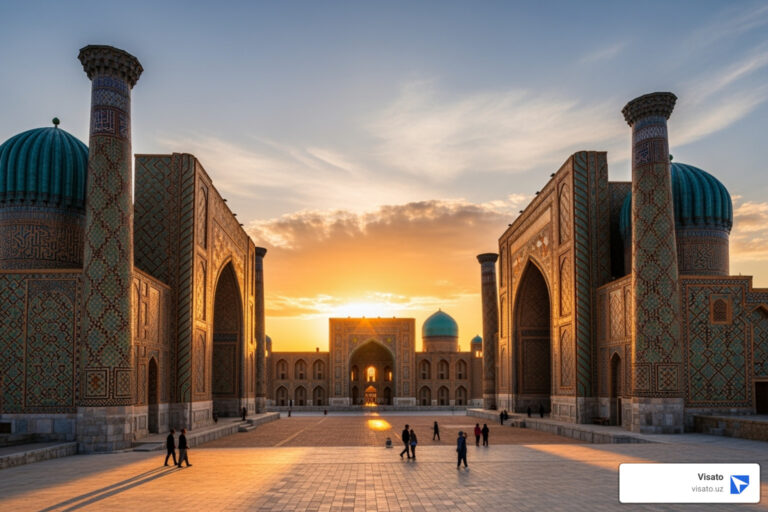Why Uzbekistan is One of Central Asia’s Most Captivating Destinations
Places to visit in Uzbekistan include legendary Silk Road cities, stunning mountain ranges, and vast desert landscapes.
Top destinations to explore:
- Samarkand – UNESCO-listed Registan Square and Shah-i-Zinda necropolis
- Bukhara – Medieval old city with over 140 architectural monuments
- Khiva – Perfectly preserved walled city of Itchan Kala
- Tashkent – Modern capital with Soviet architecture and vibrant bazaars
- Fergana Valley – Traditional silk weaving and ceramic workshops
- Chimgan Mountains – Hiking trails and alpine scenery
- Aydar Lake – Desert oasis with yurt camps and camel rides
Uzbekistan holds four UNESCO World Heritage Sites and sits at the historic crossroads of the Silk Road, where diverse cultures blended for centuries. Beyond the famous turquoise domes, you can sleep in a desert yurt, hike through ancient mountain villages, or witness the stark beauty of the Aral Sea region.
With four distinct seasons and modern high-speed trains connecting major cities, exploring is easier than ever.
I’m Nariman Huseynov from Visato. I’ve helped thousands of travelers from over 60 countries get their visas for Uzbekistan, giving me deep insight into what makes this destination unforgettable.
The Silk Road Trio: Essential Places to Visit in Uzbekistan
These three UNESCO World Heritage cities form the golden triangle of Uzbek tourism. Samarkand, Bukhara, and Khiva are open-air museums where every corner tells a story from the Silk Road’s golden age, making them the most essential places to visit in Uzbekistan.
Samarkand: The Crossroads of Cultures
Samarkand’s heart is Registan Square, a breathtaking plaza framed by three massive madrasahs: the Ulugbek, Sherdor, and Tilla-Kori. Their facades shimmer with intricate azure mosaics, a testament to the grandeur of Timur’s 14th-century empire when he made Samarkand his capital.
Nearby, the Gur-e-Amir Mausoleum holds Timur’s tomb beneath a magnificent fluted azure dome, one of Uzbekistan’s most iconic symbols. A short walk away, the Shah-i-Zinda Necropolis is an avenue of mausoleums adorned with some of the finest tilework in the Islamic world. It remains a living pilgrimage site.
Don’t miss the ruins of the Ulugh Beg Observatory, a 15th-century marvel that produced star charts used in Europe for centuries. The nearby Bibi-Khanym Mosque, built with colossal ambition by Timur, still impresses with its massive scale despite centuries of decay and restoration.
Bukhara: The Soul of the Silk Road
Where Samarkand awes with grandeur, Bukhara charms with its intimate, remarkably preserved medieval center. For centuries, it was a major hub of Islamic theology and Sufism.
The city’s skyline is dominated by the Kalyan Minaret, part of the Poi Kalyan Complex. Standing since 1127, this 45.6-meter tower so impressed Chinggis Khan that he spared it while his army razed the rest of the city. The adjacent Kalon Mosque can hold 12,000 worshippers.
The Ark of Bukhara, a massive fortress dating to the 5th century, served as the residence for the city’s rulers until 1920. For a more relaxed atmosphere, visit the Lyabi-Hauz Ensemble, a 17th-century plaza built around a pool where locals and travelers gather for tea under mulberry trees.
Other highlights include the Chor Minor Madrasah with its four unique turquoise domes and the 10th-century Samanid Mausoleum, a masterpiece of geometric brickwork.
Khiva: A Journey Back in Time
Stepping into Itchan Kala, Khiva’s inner walled city, feels like entering a film set. This perfectly preserved town was Uzbekistan’s first UNESCO World Heritage site. Thick mud walls enclose over 50 monuments and the homes of 250 families who still live within this open-air museum.
The stubby but stunning Kalta Minor Minaret immediately draws the eye with its vibrant blue and green tiles. Inside the Juma Mosque, you’ll find a forest of 218 uniquely carved wooden columns, some over a thousand years old.
The Kuhna Ark was the fortress of Khiva’s rulers; its watchtower offers panoramic sunset views over the city’s golden-hued walls and glowing domes. For the best views, climb the 57-meter Islam Hoja Minaret, Uzbekistan’s tallest. The tile-adorned Pahlavon Mahmud Mausoleum, honoring Khiva’s patron saint, offers a moment of quiet reflection.
Beyond the Main Route: More Cities and Cultural Hubs
The legendary trio of Samarkand, Bukhara, and Khiva are just the beginning. The places to visit in Uzbekistan extend far beyond, revealing a country of Soviet grandeur, ancient crafts, and poignant modern history.
Tashkent: The Modern & Soviet Heart
As Central Asia’s largest city, Tashkent deserves exploration. After a devastating 1966 earthquake, it was rebuilt as a model Soviet city, resulting in a capital defined by monumental architecture and wide avenues. The Monument of Courage honors this pivotal moment.
Start at Amir Timur Square, anchored by the Amir Timur Museum and the imposing Soviet-style Hotel Uzbekistan. However, the city’s true gem is its Metro system. Each station is an underground art gallery with unique mosaics, chandeliers, and marble designs. For a taste of traditional life, dive into the chaos of Chorsu Bazaar under its massive turquoise dome, a hub of colors, smells, and local energy.
Fergana Valley: A Top Place to Visit in Uzbekistan for Artisanal Crafts
This fertile valley is the heartland of Uzbek craftsmanship. In Margilan, the silk capital for over a millennium, the Yodgorlik Silk Factory demonstrates the entire process of creating traditional ikat textiles. In Rishtan, famous for its blue-green ceramics for over 1,000 years, you can visit the workshops of master craftsmen like Rustam Usmanov. Kokand, a former khanate capital, boasts the dazzling Khan’s Palace and historic mosques.
Off-the-Beaten-Path Gems
For those willing to venture further, these destinations offer unique rewards.
Shakhrisabz, Timur’s birthplace, is a UNESCO site an easy day trip from Samarkand. The monumental gate arches of his Ak-Saray Palace are all that remain, but their scale is breathtaking. The Dorut Tilovat and Dorus Siyadat complexes house a beautiful mosque and the tomb of Timur’s eldest son.
Termez, near the Afghan border, was a major center for Buddhism. The ruins of monasteries at Kara Tepe and Fayaz Tepe, along with the excellent Termiz Archaeological Museum, reveal a pre-Islamic history shaped by cultures from Greece to India.
The autonomous republic of Karakalpakstan offers a different kind of journey. In its capital, Nukus, the Savitsky Museum holds a priceless collection of Russian avant-garde art, saved from Soviet destruction by one visionary collector. From there, visit Moynaq, once a port on the Aral Sea. Today, its ship graveyard—rusting vessels stranded in the desert—is a haunting monument to one of the 20th century’s greatest environmental disasters.
Uzbekistan’s Natural Wonders: From Mountains to Deserts
Beyond the turquoise domes, Uzbekistan has a wild side that offers incredible adventures. From snow-capped peaks to vast deserts, the country’s natural landscapes are among the most surprising places to visit in Uzbekistan.
The Mountains: Hiking and Scenic Escapes
Just a short drive from Tashkent, the Chimgan Mountains offer an alpine escape known as “Uzbek Switzerland.” With peaks reaching over 3,300 meters, these mountains provide a dramatic contrast to the desert cities, offering year-round activities from skiing in winter to hiking and horseback riding in summer.
For a more remote experience, the Nuratau Mountains are a hub for eco-tourism. Here, you can stay in a village homestay with local Tajik families, share meals, and hike trails that few tourists ever see. It’s a genuine opportunity to experience traditional village life.
Zaamin National Park is another gem, famous for its juniper forests and stunning landscapes, offering pristine trails for hiking and picnicking.
The Desert and Lakes: Unique Landscapes
The Kyzylkum Desert, meaning “Red Sand,” covers a massive portion of Uzbekistan. This is an adventure playground where you can ride camels, stay in traditional yurt camps, and witness unbelievably clear, star-filled night skies.
The desert’s biggest surprise is Aydar Lake, a massive body of water created accidentally in 1969 by a dam overflow. This surreal oasis, stretching 250 kilometers, offers a stunning contrast to the surrounding sand dunes.
Top 3 Activities at Aydar Lake:
- Yurt Stay – Experience nomadic life in a felt tent under the desert stars.
- Camel Riding – Trek across the dunes to see the landscape like ancient nomads.
- Swimming and Fishing – Take a refreshing dip or fish in the lake’s cool waters.
History buffs can explore the Ancient Desert Fortresses of Khwarezm. The Elliq Qala (“50 Fortresses”) complex includes mud-brick ruins dating back over 2,200 years, offering a visceral connection to the civilizations that thrived here long before the Silk Road.
Practical Guide for Your Uzbekistan Adventure
After exploring these incredible places to visit in Uzbekistan, here are some practical insights to help you plan your journey.
Best Time to Visit and How Long to Stay
Spring (mid-April to early June) and autumn (mid-September to early November) are the best times to visit, offering mild temperatures perfect for sightseeing. Summer can be scorching, while winter is cold but has far fewer crowds.
For a whirlwind tour of the main highlights, 7 days is possible, but you’ll be rushed. I recommend at least 10 days to soak in the atmosphere. With 14 days or more, you can venture beyond the Silk Road route to the Fergana Valley, the mountains, or the Aral Sea region.
Getting Around: Trains, Taxis, and More
Uzbekistan is surprisingly easy to steer. Modern high-speed trains (Afrosiyob) connect Tashkent, Samarkand, and Bukhara quickly and comfortably. Slower, more economical Sharq trains are also available. Book tickets in advance via Uzbekistan Railways, especially during peak season, as they sell out.
Within cities, the Yandex Taxi app is a game-changer. It provides upfront fares and eliminates haggling. For more remote destinations, shared taxis are a common and affordable option, while domestic flights from Tashkent can save travel time to distant spots like Khiva or Nukus.
Culinary Highlights and Accommodation
Uzbek cuisine is a delicious window into Silk Road culture. You must try plov (or “osh”), the national dish of fragrant rice cooked with tender meat, carrots, and spices. Also look for samsa (savory pastries from tandoor ovens), lagman (hand-pulled noodles in a rich stew), and shurpa (a clear, flavorful soup). Freshly baked non bread is served with every meal and is an absolute delight.
For accommodation, family-run guesthouses offer authentic Uzbek hospitality and incredible homemade breakfasts. In Bukhara and Khiva, consider boutique hotels in historic buildings, which blend 19th-century charm with modern comforts.
Visa and Entry Requirements
Uzbekistan has greatly simplified its visa policy. Citizens of many countries, including the EU, Canada, and Australia, can enjoy visa-free travel for up to 30 days.
For citizens of 76 other countries, including the United States, China, and India, entry is handled through the electronic entry visa process. While the application is online, ensuring all requirements are met for a smooth approval can be complex. The e-visa allows a 30-day stay, ample time to explore the amazing places to visit in Uzbekistan. At Visato, we specialize in making this process seamless. Applying with our help ensures you avoid common pitfalls and gives you peace of mind as your departure date approaches.
Always check the latest requirements before you travel. You can plan your trip with our Uzbekistan e-visa guide for step-by-step assistance.
Conclusion
Uzbekistan offers a journey through history, culture, and stunning natural beauty. The places to visit in Uzbekistan range from the legendary Silk Road cities of Samarkand, Bukhara, and Khiva to the modern capital of Tashkent and the artisan workshops of the Fergana Valley.
Beyond the architectural marvels, you can explore the alpine serenity of the Chimgan Mountains, sleep in a yurt by the desert oasis of Aydar Lake, or witness the poignant story of the Aral Sea at Moynaq. These lesser-known destinations often become the most cherished memories.
What makes Uzbekistan truly unforgettable is its living history and the warmth of its people. It’s tasting fresh non bread from a tandoor, sharing tea with locals, and seeing ancient crafts practiced today.
With improved infrastructure and a straightforward visa process, exploring this Central Asian gem has never been easier. Whether you have a week or a month, Uzbekistan welcomes you.
Ready to turn your travel dreams into reality? We’re here to help you take the first step.

